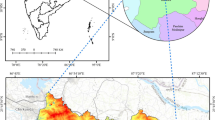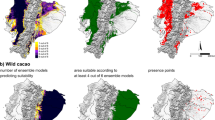Abstract
The spatial resolution of source data, the impact factor selection on the grid model and the size of the grid might be the main limitations of global land datasets applied on a regional scale. Quantitative studies of the impacts of rasterization on data accuracy can help improve data resolution and regional data accuracy. Through a case study of cropland data for Jiangsu and Anhui provinces in China, this research compared data accuracy with different data sources, rasterization methods, and grid sizes. First, we investigated the influence of different data sources on gridded data accuracy. The temporal trends of the History Database of the Global Environment (HYDE), Chinese Historical Cropland Data (CHCD), and Suwan Cropland Data (SWCD) datasets were more similar. However, different spatial resolutions of cropland source data in the CHCD and SWCD datasets revealed an average difference of 16.61% when provincial and county data were downscaled to a 10 × 10 km2 grid for comparison. Second, the influence of selection of the potential arable land reclamation rate and temperature factors, as well as the different processing methods for water factors, on accuracy of gridded datasets was investigated. Applying the reclamation rate of potential cropland to grid-processing increased the diversity of spatial distribution but resulted in only a slightly greater standard deviation, which increased by 4.05. Temperature factors only produced relative disparities within 10% and absolute disparities within 2 km2 over more than 90% of grid cells. For the different processing methods for water factors, the HYDE dataset distributed 70% more cropland in grid cells along riverbanks, at the abandoned Yellow River Estuary (located in Binhai County, Yancheng City, Jiangsu Province), and around Hongze Lake, than did the SWCD dataset. Finally, we explored the influence of different grid sizes. Absolute accuracy disparities by unit area for the year 2000 were within 0.1 km2 at a 1 km2 grid size, a 25% improvement over the 10 km2 grid size. Compared to the outcomes of other similar studies, this demonstrates that some model hypotheses and grid-processing methods in international land datasets are truly incongruent with actual land reclamation processes, at least in China. Combining the model-based methods with historical empirical data may be a better way to improve the accuracy of regional scale datasets. Exploring methods for the above aspects improved the accuracy of historical cropland gridded datasets for finer regional scales.
Similar content being viewed by others
References
Feng Yongheng, Zhang Shihuang, He Fanneng et al., 2014. Separate reconstruction of Chinese cropland grid data in the 20th century. Progress in Geography, 33(11): 1546–1555. (in Chinese)
Fuchs R, Herold M, Verburg P H et al., 2012. A high-resolution and harmonized model approach forreconstructing and analyzing historic land changes in Europe. Biogeosciences Discussions, 9(10): 14823–14866. doi: 10.5194/bgd-9-14823-2012
Ge Quansheng, Dai Junhu, He Fanneng et al., 2003. Analysis of the quantitative change of cultivated land resources in China in the past 300 years and the driving factors analysis. Progress in Natural Science, 13(8): 825–832. (in Chinese)
Goldewijk K K, Beusen A, Van Drecht G et al., 2011. The HYDE 3.1 spatially explicit database of human induced global land-use change over the past 12000 years. Global Ecology and Biogeography, 20(1): 73–86. doi: 10.1111/j.1466-8238.2010.00587.x
Hall C A S, Tian H, Qi Y et al., 1995. Modelling spatial and temporal patterns of tropical land use change. Biogeography Journal, 22(4/5): 753–757. doi: 10.2307/2845977
He Fanneng, Li Shicheng, Zhang Xuezhen, 2011. The reconstruction of cropland area and its spatial distribution pattern in the Mid-northern Song Dynasty. Acta Geographica Sinica, 66(11): 1531–1539. (in Chinese)
He Fanneng, Li Shicheng, Zhang Xuezhen, 2012. Comparisons of reconstructed cropland area from multiple datasets for the traditional cultivated region of China in the last 300 years. Journal of Geographical Sciences, 67(9): 1190–1200. (in Chinese)
He Fanneng, Li Shicheng, Zhang Xuezhen, 2014. Spatially explicit reconstruction of forest cover of Southwest China in the Qing Dynasty. Acta Geographica Sinica, 33(2): 260–269. (in Chinese)
Kaplan J O, Krumhardt K M, Ellis E C et al., 2011. Holocene carbon emissions as a result of anthropogenic land cover change. The Holocene, 21(5): 775–791. doi: 10.1177/0959683610386983
Li B B, Jansson U, Ye Y et al., 2013. The spatial and temporal change of cropland in the Scandinavian Peninsula during 1875–1999. Regional Environmental Change, 13(6): 1325–1336. doi: 10.1007/s10113-013-0457-z
Li Beibei, Fang Xiuqi, Ye Yu et al., 2010. The global land use data set the accuracy of regional assessments, in the northeast of China as an example. Science China Earth Sciences, 40(8): 1048–1059. (in Chinese)
Li Shicheng, He Fanneng, Chen Yisong, 2012. Gridding reconstruction of cropland spatial patterns in Southwest China in the Qing Dynasty. Progress in Geography, 31(9): 1196–1203. (in Chinese)
Li Shicheng, He Fanneng, Zhang Xuezhen, 2014. An approach of spatially-explicit reconstruction of historical forest in China: a case study in Northeast China. Acta Geographical Sinica, 69(3): 312–322. (in Chinese)
Li Shicheng, He Fanneng, Zhang Xuezhen, 2016. A spatially explicit reconstruction of cropland cover in China from 1661 to 1996. Regional Environmental Change, 16(2): 417–428. doi: 10.1007/s10113-014-0751-4
Lin Shanshan, 2007. A Study on Cropland Gridding Data Recon- Struction over Chinese Traditional Agricultural Area in Qing Dynasty. Beijing: University of Chinese Academy of Sciences. (in Chinese)
Lin Shanshan, Zheng Jingyun, He Fanneng, 2009. Gridding cropland data reconstruction over the agricultural region of China in 1820. Journal of Geographical Sciences, 19: 36–48. doi: 10.1007/s11442-009-0036-x
Long Ying, Jin Xiaobin, Li Miaoyi et al., 2014. A constrained cellular automata model for reconstructing historical arable land in Jiangsu province. Geographical Research, 33(12): 2239–2250. (in Chinese)
Luo Jing, Chen Qiong, Liu Fenggui et al., 2015. Methods for reconstructing historical cropland spatial distribution of the Yellow River-Huangshui River valley in Tibetan Plateau. Pro-Progress in Geography, 34(2): 207–216. (in Chinese)
Luo Jing, Zhang Yili, Liu Fenggui et al., 2014. Reconstruction of cropland spatial patterns for 1726 on Yellow River-Huangshui River Valley in northeast Qinghai-Tibet Plateau. Geographical Research, 33(7): 1285–1296. (in Chinese)
Ramankutty N, Foley J A, 2010. ISLSCP II historical croplands cover, 1700–1992. In: Hall F G et al. (eds.). ISLSCP Initiative II Collection. Tennessee: Oak Ridge National Laboratory Distributed Active Archive Center, 1–20. doi: 10.3334/ORNLDAAC/966
The agriculture of China, Anhui volume editor committee, 1998. The Agriculture of China, Anhui Volume. Beijing: China Agriculture Press. (in Chinese)
The agriculture of China, Jiangsu volume editor committee, 1998. The Agriculture of China, Jiangsu Volume. Beijing: China Agriculture Press. (in Chinese)
Wei Xueqiong, Ye Yu, Cui Yujuan et al., 2014. Review of China’s historical land cover change reconstructions. Advances in Earth science, 29(9): 1037–1045. (in Chinese)
Yang Xuhong, Guo Beibei, Jin Xiaobin et al., 2015. Reconstructing spatial distribution of historical cropland in China’s traditional cultivated region: methods and case study. Chinese Geographical Science, 25(5): 629–643. doi: 10.1007/s11769-015-0753-2
Ye Y, Fang X Q, Ren Y Y et al. 2009. Cropland cover change in Northeast China during the past 300 years. Science in China Series D: Earth Sciences, 52(8): 1172–1182. doi: 10.1007/s11430-009-0118-8
Yuan Cun, 2015. Gridding and Accuracy Comparison of Cropland Data in Jiangsu and Anhui Provinces During the Past 300 years. Beijing: Beijing Normal University. (in Chinese)
Yuan Cun, Ye Yu, Fang Xiuqi, 2015. Rasterizing cropland data and accuracy comparison in Jiangsu and Anhui ProVinces in the Mid-Qing Dynasty. Progress in Geography, 34(1): 83–91. (in Chinese)
Zhang Jiacheng, 1982. Possible impact of climate variation on agricultural in China. Geography Research, 1(2): 8–15. (in Chinese)
Zhang Lijuan, Jiang Lanqi, Zhang Xuezhen et al., 2014. Reconstruction of cropland over Heilongjiang Province in the late 19th century. Acta Geographica Sinica, 69(4): 448–458. (in Chinese)
Zhang Xuezhen, He fanneng, Li Shicheng, 2013. Reconstructed cropland in the mid-eleventh century in the traditional agricultural area of China: implications of comparisons among datasets. Regional Environmental Change, 13(5): 969–977. doi: 10.1007/s10113-012-0390-6.
Zhao Yun, 2005. Jiangsu and Anhui Area Land Use and its Driving Mechanism. Shanghai: Fudan University. (in Chinese)
Zhu Feng, Cui Xuefeng, Miu Lijuan, 2012. China’s spatiallyexplicit historical land-use data and its reconstruction methodology. Progress in Geography, 31(12): 1563–1573. (in Chinese)
Author information
Authors and Affiliations
Corresponding author
Additional information
Foundation item: Under the auspices of National Natural Science Foundation of China (No. 41471156, 41501207), the Strategic Priority Research Program of the Chinese Academy of Sciences (No. XDA05080102), Special Fund of National Science and Technology of China (No. 2014FY130500)
Rights and permissions
About this article
Cite this article
Yuan, C., Ye, Y., Tang, C. et al. Accuracy comparison of gridded historical cultivated land data in Jiangsu and Anhui provinces. Chin. Geogr. Sci. 27, 273–285 (2017). https://doi.org/10.1007/s11769-017-0862-1
Received:
Accepted:
Published:
Issue Date:
DOI: https://doi.org/10.1007/s11769-017-0862-1




